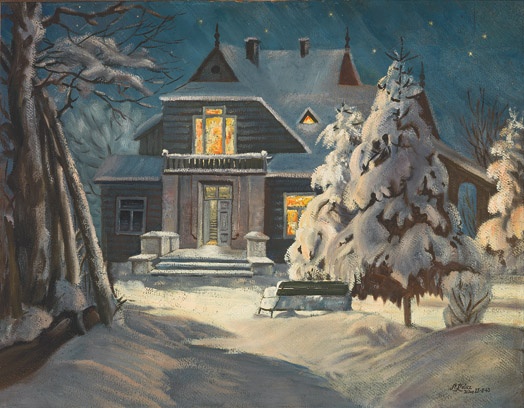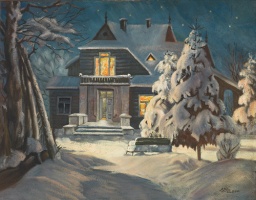
A house at night
| Author: |
Stanisław Rolicz (1913–1997) |
| Created: | 1943 |
| Material: | cardboard |
| Technique: | oil |
| Dimensions: | 55 × 71 cm |
| Signature: | bottom right: St. Rolicz / Wilno 23-II-43 |
The graphic artist and painter Stanisław Rolicz (1913–1997) studied in the Art Department at Stephen Báthory University, and between 1940 and 1941 he continued his studies at Vilnius Academy of Art. He produced many engravings of Vilnius, and also painted in oils. One of his works is the painting A house at night. This typical wooden house in suburban Vilnius with a columned portico, resembling a small estate, is portrayed at night in winter, surrounded by snow-covered trees and deep piles of snow. The picture was painted during the German occupation. The open door of the porch invites us in, and the windows glowing in the night suggest that there is a party going on. It is like an intimate memory of the pre-war days, an escape from the terrible reality of war. The exact date (23 February 1943) written on the picture could be meant to mark a name day or some other occasion, but at the same time the work has a symbolic meaning: a private space, a house, is a peaceful refuge from the nightly misfortunes of war.
Text author Laima Laučkaitė
The Polish artists were in a more precarious position than the Lithuanians. After the closure of Stephen Báthory University, many of its professors could not find work at institutions founded by the Soviet authorities. Some had to look for an alternative source of income. Artistic life did not stop, but it was dominated by Lithuanian artists, members of the Lithuanian Artists’ Union, the rules for which had been laid down by the Soviet and Nazi occupying authorities. The Nazi authorities put restrictions on artists of Slavic origin participating in official art activities, and would not allow them to show their work. However, this did not mean that Polish artists stopped working. Most professors and former students from the university lived in Vilnius until 1946 or 1947, when they were forced to move to Poland, taking the Vilnius art tradition to Gdansk, Toruń and other Polish cities.
Text authors Dovilė Barcytė and Ieva Burbaitė
Source: Law firm Valiunas Ellex art album VILNIUS. TOPOPHILIA I (2014). Compiler and author Laima Laučkaitė, KAUNAS–VILNIUS / 1918–1945 (2021). Compilers and text authors Dovilė Barcytė and Ieva BurbaitėExpositions: "1918-1945 / Kaunas-Vilnius", 27 August 2020 – 21 August 2021, Lithuanian Art Centre TARTLE (Užupio St. 40, Vilnius). Curators Dovilė Barcytė and Ieva Burbaitė. "Vilnius Time", 5 June 2023 – 1 May 2024, Lithuanian Art Centre TARTLE (Užupio St. 40, Vilnius). Curators Ieva Burbaitė and Emilija Vanagaitė.







